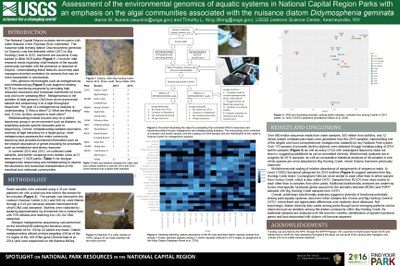Spotlight Posters on National Park Resources
Natural Resource Education and Outreach in a Cultural Resource Park: Expanding the Audience
Giessell Aguilar, Alison Sloop - Biological Science Technician(s) NPS, Manassas National Battlefield Park
 The historic significance of Manassas is the primary interpretive theme for the park. However, the park’s 5,000 acres are becoming more significant as a natural resource site due to rapidly increasing urban development. This situation does offer opportunity, as the park provides easy access for local schools and educational groups and is an ideal location from which to study natural processes. In 2013 we began a 4-year initiative with the goal of increasing the awareness and subsequently the use of the park for education and recreation. Some accomplishments to date include; establishment of two “Track Trail” self-guided tours, a park specific brochure that connects our cultural and natural resources, partnerships with local schools, outreach to local pediatrician offices, outreach to Hispanic TV and conversion of materials to Spanish, and creation of a natural resource app. Well over 15,000 youth have been reached with over 100 youth volunteers participating.
The historic significance of Manassas is the primary interpretive theme for the park. However, the park’s 5,000 acres are becoming more significant as a natural resource site due to rapidly increasing urban development. This situation does offer opportunity, as the park provides easy access for local schools and educational groups and is an ideal location from which to study natural processes. In 2013 we began a 4-year initiative with the goal of increasing the awareness and subsequently the use of the park for education and recreation. Some accomplishments to date include; establishment of two “Track Trail” self-guided tours, a park specific brochure that connects our cultural and natural resources, partnerships with local schools, outreach to local pediatrician offices, outreach to Hispanic TV and conversion of materials to Spanish, and creation of a natural resource app. Well over 15,000 youth have been reached with over 100 youth volunteers participating.
Assessment of the Environmental Genomics of Aquatic Systems in the National Park Service’s National Capital Region with Emphasis on the Algal Communities Associated with the Nuisance Diatom Didymosphenia geminata
Aaron Aunins - Genetics Biologist, Tim King - Fishery Biologist (Genomics), U.S. Geological Survey, Leetown Science Center
While water quality monitoring programs are already in place to oversee trends in health of NCR aquatic resources, these programs are not specifically designed to detect the appearance of nuisance species such as the diatom Didymosphenia geminata, which may present but at low abundance, or to assess more fine-scale characteristics of streams such as the taxonomic diversity and functional potential of the resident microbial communities. Fortunately, new genomic technologies such as metagenomics and metabarcoding are gaining traction as valuable additions to existing monitoring programs worldwide due to their ability to characterize aquatic community structure and function at reasonable cost, and at a level of sensitivity never before available. Here, we present data on an ongoing metagenomics and metabarcoding study of select stream sites collected from among all 11 NCR parks in 2014 and 2015 in order to assess differences in taxonomic and functional diversity in streams with and without D. geminata.
Partnering for Climate Change Communication in the National Capital Region
Jenell M. Walsh -Thomas, Melissa A. Clark, and Lindsey Beall, Graduate Students, George Mason University, Center for Climate Change Communication
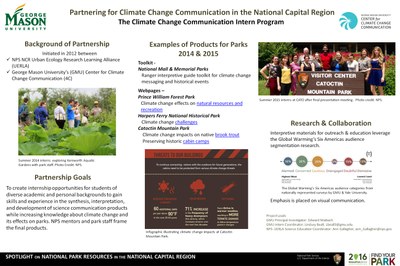 In 2012, the Urban Ecology Research Learning Alliance in the National Capital Region and the Center for Climate Change Communication (4C) formed a partnership to communicate about local climate change impacts on natural and cultural resources. The partnership supports NCR parks in telling their climate change stories. The internship involves eight interdisciplinary undergraduate and graduate interns. NPS and 4C mentors work with interns to develop outreach and education products, which leverage traditional and emerging communication modes. Products have addressed communication needs, structured web resources, and connected visitor experiences with park-specific climate change impacts. Interns have developed wayside content, webpages, social media posts, videos, infographics, and interpretive tools. We have evaluated materials informally and formally through presentations to park staff and surveys in NCR. We see this program’s success as a model for other regions, agencies, and NGO’s as a method to start discussions with stakeholders about localized climate impacts.
In 2012, the Urban Ecology Research Learning Alliance in the National Capital Region and the Center for Climate Change Communication (4C) formed a partnership to communicate about local climate change impacts on natural and cultural resources. The partnership supports NCR parks in telling their climate change stories. The internship involves eight interdisciplinary undergraduate and graduate interns. NPS and 4C mentors work with interns to develop outreach and education products, which leverage traditional and emerging communication modes. Products have addressed communication needs, structured web resources, and connected visitor experiences with park-specific climate change impacts. Interns have developed wayside content, webpages, social media posts, videos, infographics, and interpretive tools. We have evaluated materials informally and formally through presentations to park staff and surveys in NCR. We see this program’s success as a model for other regions, agencies, and NGO’s as a method to start discussions with stakeholders about localized climate impacts.
Next-Generation DNA Sequencing of Prey Species in Coyote Scat from Prince William Forest Park and Manassas National Battlefield Park
Tyler Biles - Graduate Student, Clair Fremuth, Chelsea Miller - Undergraduate Students, Brian Masters, Harald Beck - Professors Towson University, Department of Biological Sciences
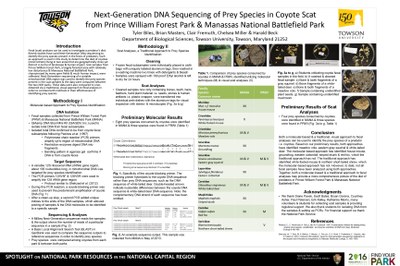 Fecal (scat) analyses can be used to investigate a predator’s diet. Recent studies have used Next-Generation DNA sequencing to identify the prey species present in the feces of predators. Such an approach is used in this study to determine the diet of coyotes (Canis latrans) living in two areas that are geographically close yet distinct in terms of landscape & human impact. Scat samples from Prince William Forest Park, a largely forested area with relatively low disturbance & Manassas National Battlefield Park, characterized by many open fields & much human impact, were collected. Next-Generation sequencing of a variable mitochondrial DNA region was used to identify the prey species present in the scat samples & the data were compared between the two NCR parks. These data were also compared to ones obtained via a traditional, visual approach to fecal analysis to contrast both methods in their effectiveness of identifying prey species.
Fecal (scat) analyses can be used to investigate a predator’s diet. Recent studies have used Next-Generation DNA sequencing to identify the prey species present in the feces of predators. Such an approach is used in this study to determine the diet of coyotes (Canis latrans) living in two areas that are geographically close yet distinct in terms of landscape & human impact. Scat samples from Prince William Forest Park, a largely forested area with relatively low disturbance & Manassas National Battlefield Park, characterized by many open fields & much human impact, were collected. Next-Generation sequencing of a variable mitochondrial DNA region was used to identify the prey species present in the scat samples & the data were compared between the two NCR parks. These data were also compared to ones obtained via a traditional, visual approach to fecal analysis to contrast both methods in their effectiveness of identifying prey species.
Mapping Potential Wetland Habitat Throughout the C&O Canal National Historical Park using Remote Sensing and GIS-based Data
Lance Bragin - Graduate Student, Hood College, Environmental Biology Program
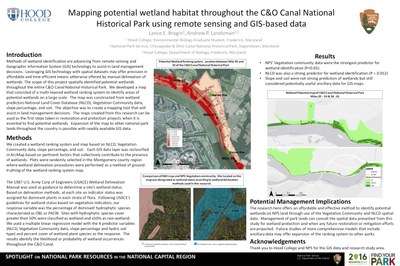 Methods of wetland identification are advancing from remote sensing and Geographic Information System (GIS) technology to assist in land management decisions. We developed a map that consisted of a multi- layered wetland ranking system to identify areas of potential wetlands on a large scale. The map was constructed from wetland predictors National Land Cover Database (NLCD), Vegetation Community data (from National Park Service/NatureServe), slope percentage, and soil. The ranking system’s potential wetland scores were ground-truthed with wetland delineation procedures inside NPS’ C&O Canal National Historical Park. Vegetation community data were the strongest predictor for wetland identification followed by NLCD. Slope and soil were not strong predictors of wetlands but still considered potentially useful ancillary data. This research indicates the strength in identifying potential wetlands based on NPS’s vegetation community data. Future studies of more comprehensive models that include ancillary data may offer expansion of the ranking system to other parks.
Methods of wetland identification are advancing from remote sensing and Geographic Information System (GIS) technology to assist in land management decisions. We developed a map that consisted of a multi- layered wetland ranking system to identify areas of potential wetlands on a large scale. The map was constructed from wetland predictors National Land Cover Database (NLCD), Vegetation Community data (from National Park Service/NatureServe), slope percentage, and soil. The ranking system’s potential wetland scores were ground-truthed with wetland delineation procedures inside NPS’ C&O Canal National Historical Park. Vegetation community data were the strongest predictor for wetland identification followed by NLCD. Slope and soil were not strong predictors of wetlands but still considered potentially useful ancillary data. This research indicates the strength in identifying potential wetlands based on NPS’s vegetation community data. Future studies of more comprehensive models that include ancillary data may offer expansion of the ranking system to other parks.
Bats, White-nose Syndrome, and the Western Maryland Railroad Tunnels
Michelle Carter - Natural Resource Program Manager NPS, C&O Canal National Historical Park
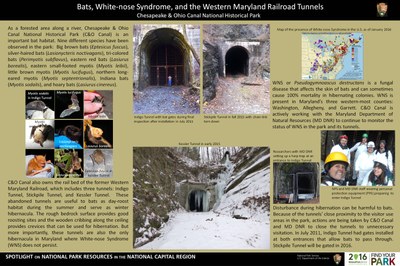 White-nose Syndrome (WNS), Pseudogymnoascus destructans, is a fungal disease the affects the skin of hibernating bats and has a high mortality rate. WNS has been found in caves in Maryland’s three western-most counties. The three abandoned railroad tunnels along the Western Maryland Railroad are the only known bat hibernacula that show no signs of WNS and these fall within C&O Canal’s boundaries. C&O Canal is an important bat habitat since it is a forested area along the Potomac River and nine different species of bat have been recorded in the park. The fact that the only three hibernacula free of WNS fall within its boundaries calls for the tunnels to protected from any unnecessary disturbance. Currently, one tunnel is gated and construction on another will start in 2016. C&O Canal and MD DNR are partnering to continue studies of the tunnels and monitoring the status of WNS with in them.
White-nose Syndrome (WNS), Pseudogymnoascus destructans, is a fungal disease the affects the skin of hibernating bats and has a high mortality rate. WNS has been found in caves in Maryland’s three western-most counties. The three abandoned railroad tunnels along the Western Maryland Railroad are the only known bat hibernacula that show no signs of WNS and these fall within C&O Canal’s boundaries. C&O Canal is an important bat habitat since it is a forested area along the Potomac River and nine different species of bat have been recorded in the park. The fact that the only three hibernacula free of WNS fall within its boundaries calls for the tunnels to protected from any unnecessary disturbance. Currently, one tunnel is gated and construction on another will start in 2016. C&O Canal and MD DNR are partnering to continue studies of the tunnels and monitoring the status of WNS with in them.
Paleo-Protectors: the First Volunteer Monitoring of Paleontological Resources within the National Park Service
Michelle Carter - Natural Resource Program Manager NPS, C&O Canal National Historical Park
 In the summer of 2014, CHOH began a new volunteer monitoring program, the Paleo-Protectors. Recruited from a base of experienced and trusted park volunteers, the Paleo-Protectors monitor several of the many important paleontological localities with in the park. The program is similar to the Sites Stewards Program, which monitors sensitive archeological resources; however, this is the first program within NPS specifically for monitoring paleontological resources. Volunteers visit their sites at least once a year and monitor for erosion, fossil abundance, and possible fossil poaching, as well as other relevant data. Beginning in 2009, the National Capital Region partnered with the Geologic Resource Division to build paleontological resource inventories within the region. Since then four visiting paleontologists through GeoCorps America have helped in this effort which produced the Paleo- Protectors program: Erica Clites, Katie Loughney, Ivan Carabajal, and Liz Keily.
In the summer of 2014, CHOH began a new volunteer monitoring program, the Paleo-Protectors. Recruited from a base of experienced and trusted park volunteers, the Paleo-Protectors monitor several of the many important paleontological localities with in the park. The program is similar to the Sites Stewards Program, which monitors sensitive archeological resources; however, this is the first program within NPS specifically for monitoring paleontological resources. Volunteers visit their sites at least once a year and monitor for erosion, fossil abundance, and possible fossil poaching, as well as other relevant data. Beginning in 2009, the National Capital Region partnered with the Geologic Resource Division to build paleontological resource inventories within the region. Since then four visiting paleontologists through GeoCorps America have helped in this effort which produced the Paleo- Protectors program: Erica Clites, Katie Loughney, Ivan Carabajal, and Liz Keily.
Maximizing the use of Volunteers for the Removal of Arborized Invasive English Ivy Vine at Rock Creek Park
Nick Bartolomeo - Chief of Resource Management, Ana Chuquin - Biological Science Technician NPS, Rock Creek Park, John Maleri - Program Coordinator, Karen Zeiter - Program Manager Rock Creek Conservancy
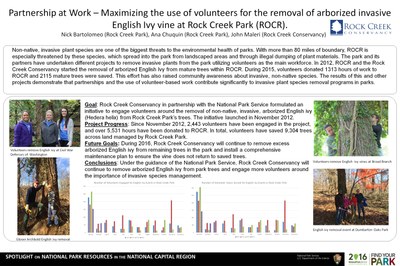 Non-native invasive plan species are one of the biggest threats to the environmental health of parks. With more than 80 miles of boundary, ROCR is especially threatened by these species, which spread into the park from lands ape areas and through illegal dumping of plant materials. The park and its partners have undertaken different projects to remove invasive plants from the park utilizing volunteers as the main workforce. In 2012, ROCR and the Rock Creek Conservancy started the removal of barbarized English Ivy from mature trees within ROCR. During 2015, volunteers donated 1313 hours of work to ROCR and 2115 mature trees were saved. The results of this and other projects demonstrate that partnerships and the use of volunteer-based work contribute significantly to invasive plant species removal programs in parks.
Non-native invasive plan species are one of the biggest threats to the environmental health of parks. With more than 80 miles of boundary, ROCR is especially threatened by these species, which spread into the park from lands ape areas and through illegal dumping of plant materials. The park and its partners have undertaken different projects to remove invasive plants from the park utilizing volunteers as the main workforce. In 2012, ROCR and the Rock Creek Conservancy started the removal of barbarized English Ivy from mature trees within ROCR. During 2015, volunteers donated 1313 hours of work to ROCR and 2115 mature trees were saved. The results of this and other projects demonstrate that partnerships and the use of volunteer-based work contribute significantly to invasive plant species removal programs in parks.
Japanese American Veterans Association Oral History Topic
 Amber Cohen - Graduate Student, University of Maryland
Amber Cohen - Graduate Student, University of Maryland
The Japanese American Veterans Association Oral History Project was initiated by the National Capital Regional Office’s Communication Department. The project’s goal was to record the oral histories of a group of Japanese Americans who were interned during WWII at sites that are now NPS units. These videos allow those who witnessed history tell their story of loyalty in the face of discrimination. This poster will include videos of the interviews.
Camera Trap Survey to Assess White-tailed Deer Population at Catoctin Mountain Park, 2015
Lindsey Donaldson - Biologist, Laurel Downs - Student Conservation Assosication NPS, Catoctin Mountain Park
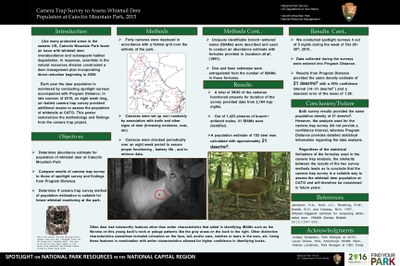 Many protected areas in the eastern US struggle with the issue of deer overabundance due to the lack of authorized hunting and the absence of natural predators such as wolves and mountain lions. Subsequent prob lems arise including habitat degradation, poor herd health, and increased negative human-wildlife interactions such as car accidents. Catoctin Mountain Park completed a deer management plan in 2009 incorporating a direct reduction strategy to resolve the white-tailed deer overabundance issue and have since seen positive results. Each year the population is monitored using spotlight surveys and Program Distance. In 2015, we implemented an additional eight week long, un-baited camera trap survey. Thirty-nine cameras (1/149acres) operated from mid-July through mid- September. Findings indicated that the park’s deer population was approximately 21 deer/mi2. We plan to compare these results with those provided by Program Distance to determine if this method of population monitoring will be considered in future years.
Many protected areas in the eastern US struggle with the issue of deer overabundance due to the lack of authorized hunting and the absence of natural predators such as wolves and mountain lions. Subsequent prob lems arise including habitat degradation, poor herd health, and increased negative human-wildlife interactions such as car accidents. Catoctin Mountain Park completed a deer management plan in 2009 incorporating a direct reduction strategy to resolve the white-tailed deer overabundance issue and have since seen positive results. Each year the population is monitored using spotlight surveys and Program Distance. In 2015, we implemented an additional eight week long, un-baited camera trap survey. Thirty-nine cameras (1/149acres) operated from mid-July through mid- September. Findings indicated that the park’s deer population was approximately 21 deer/mi2. We plan to compare these results with those provided by Program Distance to determine if this method of population monitoring will be considered in future years.
Building an Invasive Plant Watch List for the NCR
Mark Frey- Team Liaison, NPS, Exotic Plant Management Team (EPMT)
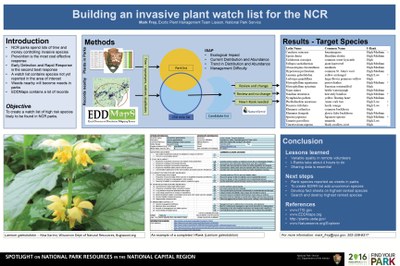 Prioritizing treatment of invasive plants improves the efficiency of an invasive plant program. One prioritization tool is a watch list; such a list contains species that are not yet known to occur in the target area but have the potential to occur. My objective was to identify priority species for a regional early detection watch list for NCR. First, I used the EDDMapS database of plant occurrences to identify non-native plants reported within 150 miles of DC. Second, I sorted the list to include only species not reported by park staff to be invasive in park natural areas. Third, the resulting 97 candidate species were classified using NatureServe’s Invasive Species Assessment Protocol (ISAP). The ISAP includes questions about ecological impact, current distribution, trend in distribution, and management difficulty. Each category contributes to an overall ranking. Removing these populations will protect natural areas and reduce management costs in future years.
Prioritizing treatment of invasive plants improves the efficiency of an invasive plant program. One prioritization tool is a watch list; such a list contains species that are not yet known to occur in the target area but have the potential to occur. My objective was to identify priority species for a regional early detection watch list for NCR. First, I used the EDDMapS database of plant occurrences to identify non-native plants reported within 150 miles of DC. Second, I sorted the list to include only species not reported by park staff to be invasive in park natural areas. Third, the resulting 97 candidate species were classified using NatureServe’s Invasive Species Assessment Protocol (ISAP). The ISAP includes questions about ecological impact, current distribution, trend in distribution, and management difficulty. Each category contributes to an overall ranking. Removing these populations will protect natural areas and reduce management costs in future years.
A Floral Survey of Cliff Habitats Along Bull Run at Manassas National Battlefield Park
Courtney James- Biological Science Technician, NPS, Manassas National Battlefield Park, Esther D. Stroh, Matthew A. Struckhoff, and Keith W. Grabner, U.S. Geological Survey, Columbia Environmental Research Center
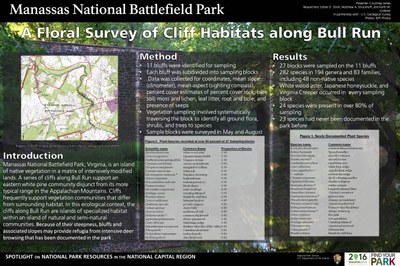 In an area of increasing development, Manassas National Battlefield Park contains some of the highest quality natural communities in the region and supports at least 706 plant species and 10 broad habitat types. However, previous floral surveys did not include the bluffs along Bull Run, and they recommended that the bluffs be thoroughly surveyed due to the occurrence of locally rare species and the refuge provided by the steep terrain from excessive deer browsing. Variations in soil, topography, and exposure can create microclimates that support a suite of species that is atypical of the surrounding landscape. Therefore, a floral survey of the cliffs was prioritized via the National Resource Preservation Program, and in 2014, a floral survey of the 11 cliffs in the park by the U.S. Geological Survey recorded 282 species in 194 genera and 83 families, including 23 newly documented species for the park.
In an area of increasing development, Manassas National Battlefield Park contains some of the highest quality natural communities in the region and supports at least 706 plant species and 10 broad habitat types. However, previous floral surveys did not include the bluffs along Bull Run, and they recommended that the bluffs be thoroughly surveyed due to the occurrence of locally rare species and the refuge provided by the steep terrain from excessive deer browsing. Variations in soil, topography, and exposure can create microclimates that support a suite of species that is atypical of the surrounding landscape. Therefore, a floral survey of the cliffs was prioritized via the National Resource Preservation Program, and in 2014, a floral survey of the 11 cliffs in the park by the U.S. Geological Survey recorded 282 species in 194 genera and 83 families, including 23 newly documented species for the park.
Ahoy Ye Landlubber! Submerged Cultural Resources along the GWMP
Bradley Krueger- Cultural Resource Specialist, NPS, George Washington Memorial Parkway
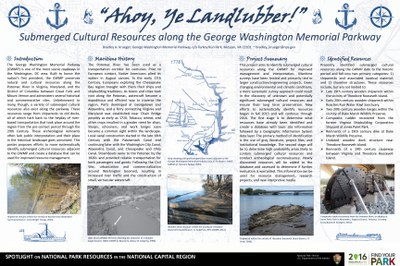 The George Washington Memorial Parkway (GWMP) is one of the most scenic roadways in the Washington, DC area. Built to honor the nation’s first president, the GWMP preserves natural and cultural resources along the Potomac River between Great Falls and Mount Vernon and administers several historical and commemorative sites. Unbeknownst to many, though, a variety of submerged cultural resources also exist along the parkway. These resources range from shipwrecks to old docks, all of which hark back to the heyday of river-based transportation that took place around the region from the pre-contact period through the twentieth century. These archeological remnants often lack public interpretation and their place in the historical landscape goes unnoticed. As such, this poster discusses the rich maritime history of the Potomac River adjacent to the GWMP and highlights a few of the submerged resources located along the water’s edge.
The George Washington Memorial Parkway (GWMP) is one of the most scenic roadways in the Washington, DC area. Built to honor the nation’s first president, the GWMP preserves natural and cultural resources along the Potomac River between Great Falls and Mount Vernon and administers several historical and commemorative sites. Unbeknownst to many, though, a variety of submerged cultural resources also exist along the parkway. These resources range from shipwrecks to old docks, all of which hark back to the heyday of river-based transportation that took place around the region from the pre-contact period through the twentieth century. These archeological remnants often lack public interpretation and their place in the historical landscape goes unnoticed. As such, this poster discusses the rich maritime history of the Potomac River adjacent to the GWMP and highlights a few of the submerged resources located along the water’s edge.
Interactions Between Climbing Vines and Forest Edges Influence Tree Mortality in Mid-Atlantic Forests
Elizabeth Matthews - Botanist, Megan Nortrup - Science Communicator, John Paul Schmit - Quantitative Ecologist, J Patrick Campbell - Network Coordinator, NPS, National Capital Region Inventory and Monitoring Program
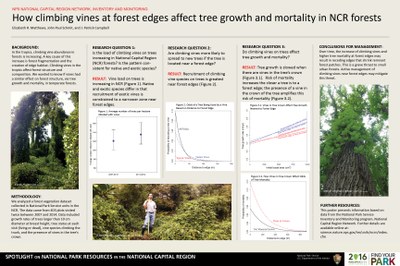 Vines are an integral component of forests, competing with trees for resources and influencing forest composition, carbon sequestration, and wildlife resources. Vine abundance is increasing in tropical forests, likely a result of fragmentation and elevated CO2. Research in temperate forests is limited, but studies in the eastern U.S. show a similar increase in abundance. The Inventory and Monitoring Program monitors forests at permanent plots in the Washington, D.C. region. Using these data, we asked: Is abundance of climbing vines increasing? Are vines more likely to spread near forest edges? Does the presence of climbing vines affect tree growth and mortality? We found that: vine abundance is increasing, climbing vines are more likely to spread to trees near forest edges, and tree mortality is greater for trees with climbing vines in their crown. Further, the effect on mortality of vines in the crown was greater for trees near a forest edge
Vines are an integral component of forests, competing with trees for resources and influencing forest composition, carbon sequestration, and wildlife resources. Vine abundance is increasing in tropical forests, likely a result of fragmentation and elevated CO2. Research in temperate forests is limited, but studies in the eastern U.S. show a similar increase in abundance. The Inventory and Monitoring Program monitors forests at permanent plots in the Washington, D.C. region. Using these data, we asked: Is abundance of climbing vines increasing? Are vines more likely to spread near forest edges? Does the presence of climbing vines affect tree growth and mortality? We found that: vine abundance is increasing, climbing vines are more likely to spread to trees near forest edges, and tree mortality is greater for trees with climbing vines in their crown. Further, the effect on mortality of vines in the crown was greater for trees near a forest edge
Upcoming Centennial BioBlitz 2016 events in the National Capital Region
James Pieper- Regional Natural Resource Specialist, NPS, Office of Natural Resources and Science
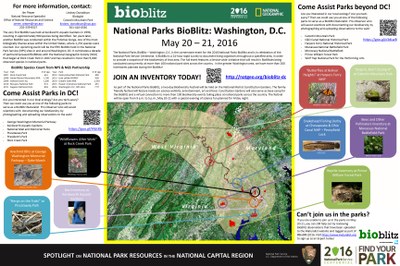 On May 20-21, 2016, National Capital Region parks will host the National Parks BioBlitz – Washington D.C., a cornerstone event to celebrate the centennial of the National Park Service and Call to Action Goal #7 Next Generation Stewards. The BioBlitz is a 24-hour event intended to document and celebrate the biodiversity that exists in our national parks. Throughout the BioBlitz, we will be using teams, comprised of scientists and naturalists working alongside students, teachers, and you, the stewards of our National Parks, to conduct focused species inventories. The ecological heterogeneity of the parks affords many opportunities to catalog, record, and study diverse organisms, ecological interactions, and biodiversity on a range of spatial and temporal scales. Concurrent with the BioBlitz inventories, we will host a Biodiversity Festival at Constitution Gardens on the National Mall. The festival will include public presentations about biodiversity, nature inspired entertainment, structured scientific field activities, demonstrations of field technology, and exhibits ranging from global biodiversity and citizen science initiatives to art and wildlife photography. Sign-up today to serve as an Inventory Leader, to be an iNaturalist Pro-Observer, to bring your classroom outside, or to be a citizen scientist. Or help us identify observations from the event, by going through pictures on iNaturalist.org.
On May 20-21, 2016, National Capital Region parks will host the National Parks BioBlitz – Washington D.C., a cornerstone event to celebrate the centennial of the National Park Service and Call to Action Goal #7 Next Generation Stewards. The BioBlitz is a 24-hour event intended to document and celebrate the biodiversity that exists in our national parks. Throughout the BioBlitz, we will be using teams, comprised of scientists and naturalists working alongside students, teachers, and you, the stewards of our National Parks, to conduct focused species inventories. The ecological heterogeneity of the parks affords many opportunities to catalog, record, and study diverse organisms, ecological interactions, and biodiversity on a range of spatial and temporal scales. Concurrent with the BioBlitz inventories, we will host a Biodiversity Festival at Constitution Gardens on the National Mall. The festival will include public presentations about biodiversity, nature inspired entertainment, structured scientific field activities, demonstrations of field technology, and exhibits ranging from global biodiversity and citizen science initiatives to art and wildlife photography. Sign-up today to serve as an Inventory Leader, to be an iNaturalist Pro-Observer, to bring your classroom outside, or to be a citizen scientist. Or help us identify observations from the event, by going through pictures on iNaturalist.org.
A Golden Anniversary in a Diamond Year
Kimberly Robinson - Museum Curator, NPS, George Washington Memorial Parkway
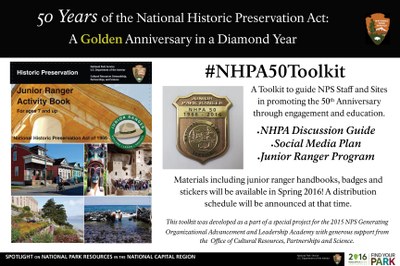 This poster will highlight efforts within the National Park Service to commemorate the 50th Anniversary of the National Historic Preservation Act of 1966. Started as a group project for the Park Service’s 2015 class of the Generating Operational Advancement and Leadership Academy, our project team assembled of professionals from across the park system is working to develop a resource toolkit to aid regions, individual park units, and park staff in commemorating the act and educating the general public. The toolkit will consist of a discussion guide, a social media plan (#NHPA50) and a junior ranger program.
This poster will highlight efforts within the National Park Service to commemorate the 50th Anniversary of the National Historic Preservation Act of 1966. Started as a group project for the Park Service’s 2015 class of the Generating Operational Advancement and Leadership Academy, our project team assembled of professionals from across the park system is working to develop a resource toolkit to aid regions, individual park units, and park staff in commemorating the act and educating the general public. The toolkit will consist of a discussion guide, a social media plan (#NHPA50) and a junior ranger program.
Accuracy Assessment Results for NCR vegetation maps
Judy Teague - Senior Ecologist, Natureserve Diane Pavek - Research Coordinator, Botanist NPS, National Capital Region
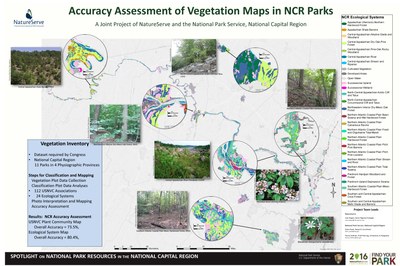 NatureServe has completed an Accuracy Assessment of the mapping of plant communities in 11 parks in the National Capital Region. An Accuracy Assessment tells park managers the level of confidence they can have that a Plant Community is correctly mapped. The plant communities were classified in 2008 and mapped by Natureserve through a partnership with the National Capital Region, NPS Vegetation Inventory Program, and the Virginia, Maryland and West Virginia Natural Heritage Programs. The maps were completed in 2012. NCR plant communities are classified at the Association level of the United States National Vegetation Classification, which is the NPS standard. Additionally, each park with a surrounding 0.5-mile buffer was mapped according to the Ecological Systems classification. This effort resulted in mapped locations of 112 Associations and 24 Ecological Systems across 11 NCR parks. These products provide resource managers with a robust classification of their plant communities within the regional landscape, and maps which will help them understand the distribution of plant communities within their parks. Workshops will be held at parks to demonstrate uses of the classification, field keys, and maps of plant communities.
NatureServe has completed an Accuracy Assessment of the mapping of plant communities in 11 parks in the National Capital Region. An Accuracy Assessment tells park managers the level of confidence they can have that a Plant Community is correctly mapped. The plant communities were classified in 2008 and mapped by Natureserve through a partnership with the National Capital Region, NPS Vegetation Inventory Program, and the Virginia, Maryland and West Virginia Natural Heritage Programs. The maps were completed in 2012. NCR plant communities are classified at the Association level of the United States National Vegetation Classification, which is the NPS standard. Additionally, each park with a surrounding 0.5-mile buffer was mapped according to the Ecological Systems classification. This effort resulted in mapped locations of 112 Associations and 24 Ecological Systems across 11 NCR parks. These products provide resource managers with a robust classification of their plant communities within the regional landscape, and maps which will help them understand the distribution of plant communities within their parks. Workshops will be held at parks to demonstrate uses of the classification, field keys, and maps of plant communities.
Creating a Mobile Experience for the Explore Natural Communities Website
Judy Teague - Senior Ecologist, Allen Ansellmo - Software Engineer, Erin Jones - Vegetation Ecologist, Dave Hauver - Software Engineer Natureserve, Diane Pavek - Research Coordinator, Ann Gallagher - Science Education Coordinator, Urban Ecology Research Learning Alliance, NPS National Capital Region
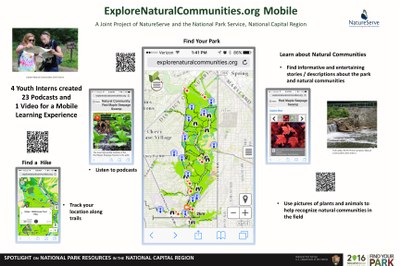 With NPS support, NatureServe formed a team including 4 college- level interns to create a mobile experience for the Explore Natural Communities website. With a mobile device (cell phone, tablet, iPad, etc.) and an internet connection, all users can access a map of the park and track their location along trails, query the map for information about nearby natural communities, use pictures of plants and animals that help form the natural communities to learn to recognize them in the field, enjoy prebuilt hikes, listen to podcasts, and watch videos all focused on the natural history and natural communities of Rock Creek Park. Check it out on your mobile device at: http://explorenaturalcommunities.org/parks-places/rock-creek-park/ mobile-map.
With NPS support, NatureServe formed a team including 4 college- level interns to create a mobile experience for the Explore Natural Communities website. With a mobile device (cell phone, tablet, iPad, etc.) and an internet connection, all users can access a map of the park and track their location along trails, query the map for information about nearby natural communities, use pictures of plants and animals that help form the natural communities to learn to recognize them in the field, enjoy prebuilt hikes, listen to podcasts, and watch videos all focused on the natural history and natural communities of Rock Creek Park. Check it out on your mobile device at: http://explorenaturalcommunities.org/parks-places/rock-creek-park/ mobile-map.


